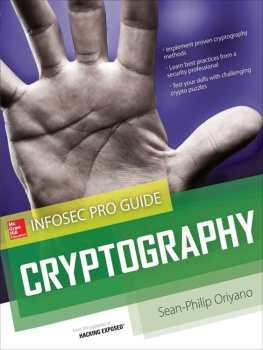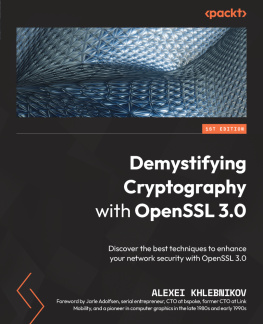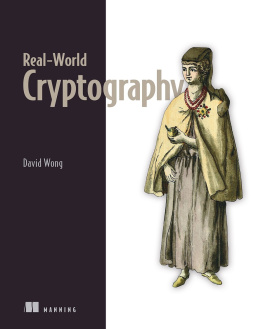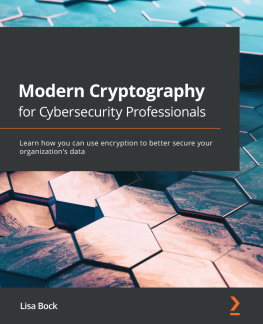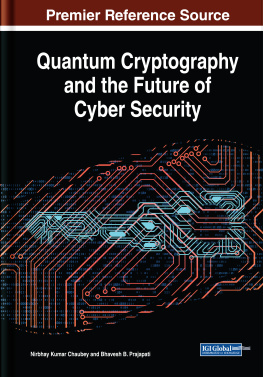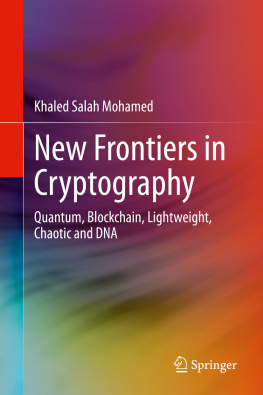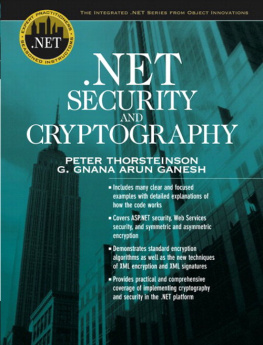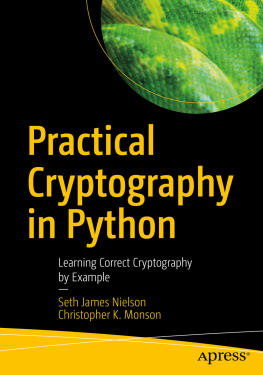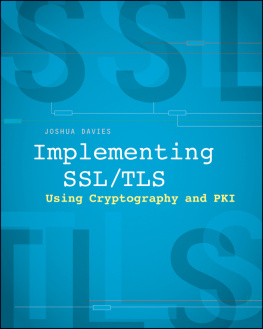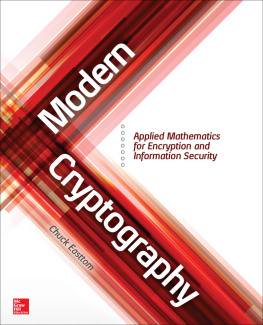Cryptography:
InfoSec Pro Guide
About the Author
Sean-Philip Oriyano is a 20+ year veteran of the information technology field, where he is an instructor, author, cyberwarfare expert, and security researcher. Over the years he has worked with many clients, including all branches of the U.S. Military as well as several international clients, and has been sought to instruct at the U.S. Air Force Academy and Naval War College. He obtained his knowledge through a combination of apprenticeships and experience over the years, attaining over 50+ certifications and licenses along the way. Sean has published several books and training videos, and he has authored a dozen research papers on topics such as hacking, forensics, and encryption.
Sean spends most of his time instructing for both public and private clients all over the world. He has consistently received praise for not only his unconventional instructional methods but also for his ability to present complex topics in an easy-to-understand way.
Sean holds many certifications and qualifications that demonstrate his knowledge and experience in the IT field, such as the CISSP, CNDA, CEH, and Security+. He is also trained in Incident Command and Management from FEMA and has earned a MEMS Badge for his efforts.
Outside of work Sean enjoys hiking, skydiving, flying, playing ice hockey, and following the greatest sports franchise ever, the Montreal Canadiens.
About the Technical Editor
Jason McDowell has had a varied government career, stemming from 11 years of service in the U.S. Air Force and then transitioning his commitment to a career as a civil servant with the Department of Interior. During his time as an active-duty member of the Air Force, Jason contributed to many different projects that immersed him in the industrial controls field as well as deployable field communications arena. Additionally, Jason performed as a unit Communications Security (COMSEC) officer, which enabled him to experience cryptography at a grassroots level. His involvement in the deployment, protection, and destruction of both Secret and Top Secret cryptographic keying materials gave him a newfound respect and appreciation for cryptography and the policy surrounding it.
Finishing his military service as a system administrator for a combat communications unit, Jason transitioned his skillset to the civil service workforce. His first position was with the Bureau of Land Management (BLM) in Las Vegas, Nevada. During his two years as an Information Technology Specialist for the BLM, Jason expanded his breadth of experience and knowledge working in a freshly built enterprise environment. He was integral in various projects that impacted the health of the company infrastructure, as well as the protection of physical and logical assets. While at the BLM, he played a lead role in upgrading perimeter security systems to meet the stringent federal facility requirements set forth by Homeland Security Policy Directive-12 (HSPD-12). He also had the opportunity to edit and generate numerous company policy documents, including the Continuity of Operations Plan and Site Security Plan.
Jasons next and current position settled him into an IT Specialist role with the U.S. Fish and Wildlife Service (FWS). Maintaining his commitment to the Department of Interior, Jasons role with the FWS has greatly expanded his scope of work and has tasked him as an IT Project Manager for multiple federal construction projects. He acts as the primary technical consultant for all ongoing Southern Nevada projects, and is working daily at a ground level with project contractors, ensuring consistency and adherence to organizational policy. Jason continues to reeducate and renew his skillset through training and course content development. His appreciation of the information technology field and all its facets has enabled him to grow his skillset through both certification and in-field application. Jason currently holds the A+, Net+, Security+, MCSA, CEH, and CISSP certifications.
Cryptography:
InfoSec Pro Guide
Sean-Philip Oriyano
New York Chicago San Francisco
Athens London Madrid
Mexico City Milan New Delhi
Singapore Sydney Toronto
Copyright 2013 by McGraw-Hill Education and InfoComm International. All rights reserved. Printed in the United States of America. Except as permitted under the Copyright Act of 1976, no part of this publication may be reproduced or distributed in any form or by any means, or stored in a database or retrieval system, without the prior written permission of publisher, with the exception that the program listings may be entered, stored, and executed in a computer system, but they may not be reproduced for publication.
ISBN: 978-0-07-179426-8
MHID: 0-07-179426-3
e-book conversion by Cenveo Publisher Services
Version 1.0
The material in this e-book also appears in the print version of this title: ISBN: 978-0-07-179425-1, MHID: 0-07-179425-5
McGraw-Hill Education e-books are available at special quantity discounts to use as premiums and sales promotions, or for use in corporate training programs. To contact a representative, please visit the Contact Us pages at www.mhprofessional.com .
All trademarks or copyrights mentioned herein are the possession of their respective owners and McGraw-Hill Education makes no claim of ownership by the mention of products that contain these marks. McGraw-Hill Education is not associated with any product or vendor mentioned in this book. InfoComm International, InfoComm, CTS, and related marks are registered trademarks of InfoComm International in the United States and/or other countries.
Information has been obtained by McGraw-Hill Education from sources believed to be reliable. However, because of the possibility of human or mechanical error by our sources, McGraw-Hill Education, or others, McGraw-Hill Education does not guarantee the accuracy, adequacy, or completeness of any information and is not responsible for any errors or omissions or the results obtained from the use of such information.
TERMS OF USE
This is a copyrighted work and McGraw-Hill Education (McGraw-Hill) and its licensors reserve all rights in and to the work. Use of this work is subject to these terms. Except as permitted under the Copyright Act of 1976 and the right to store and retrieve one copy of the work, you may not decompile, disassemble, reverse engineer, reproduce, modify, create derivative works based upon, transmit, distribute, disseminate, sell, publish or sublicense the work or any part of it without McGraw-Hills prior consent. You may use the work for your own noncommercial and personal use; any other use of the work is strictly prohibited. Your right to use the work may be terminated if you fail to comply with these terms.
THE WORK IS PROVIDED AS IS. McGRAW-HILL AND ITS LICENSORS MAKE NO GUARANTEES OR WARRANTIES AS TO THE ACCURACY, ADEQUACY OR COMPLETENESS OF OR RESULTS TO BE OBTAINED FROM USING THE WORK, INCLUDING ANY INFORMATION THAT CAN BE ACCESSED THROUGH THE WORK VIA HYPERLINK OR OTHERWISE, AND EXPRESSLY DISCLAIM ANY WARRANTY, EXPRESS OR IMPLIED, INCLUDING BUT NOT LIMITED TO IMPLIED WARRANTIES OF MERCHANTABILITY OR FITNESS FOR A PARTICULAR PURPOSE. McGraw-Hill and its licensors do not warrant or guarantee that the functions contained in the work will meet your requirements or that its operation will be uninterrupted or error free. Neither McGraw-Hill nor its licensors shall be liable to you or anyone else for any inaccuracy, error or omission, regardless of cause, in the work or for any damages resulting therefrom. McGraw-Hill has no responsibility for the content of any information accessed through the work. Under no circumstances shall McGraw-Hill and/or its licensors be liable for any indirect, incidental, special, punitive, consequential or similar damages that result from the use of or inability to use the work, even if any of them has been advised of the possibility of such damages. This limitation of liability shall apply to any claim or cause whatsoever whether such claim or cause arises in contract, tort or otherwise.

